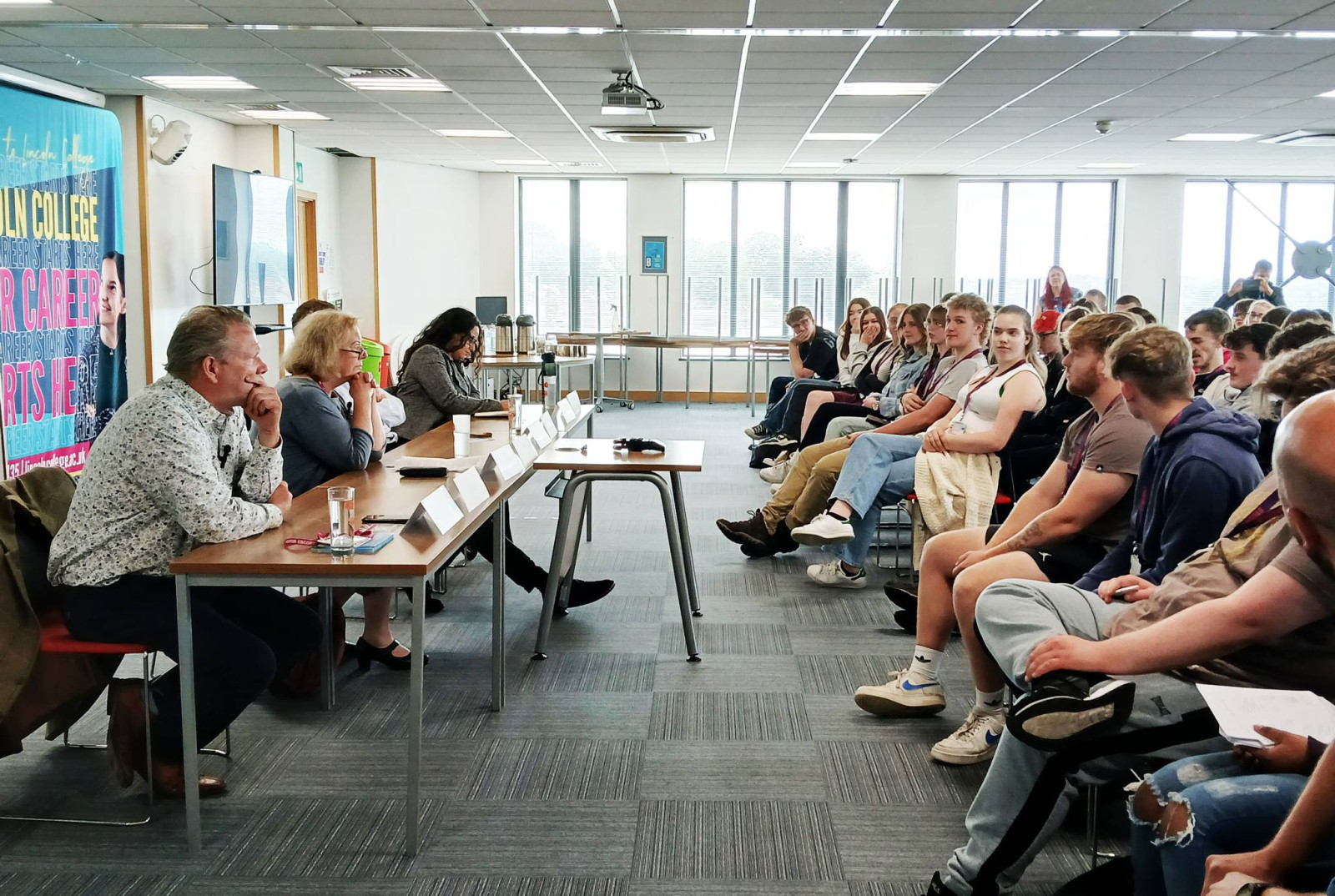The Furniture, Furnishings and Interiors industry is of significant importance to the UK economy, particularly in the supply of end products for residential and commercial living and workplaces. The industry has an annual turnover well in excess of £12 billion.
The ability to work to agreed targets in terms of output and quality standards is essential. Workplaces can be wide - ranging from small workshops to large factories. As a Furniture Manufacturer, you must be dexterous, have a good work ethic and be able to demonstrate your ability to work individually and as part of a team.
Pathway
General Furniture Manufacturer
Furniture Manufacturers are skilled craftsmen/women who make pieces of furniture. You may work in a small, independent shop that produces custom furniture or in a factory that mass-produces pieces of furniture. You will manufacture furniture such as:
Domestic – kitchens, bedrooms, living room and other items for the home
Office - desk, seating, tables and other items for the office environment
Contract - furniture for public areas such as hospitals, schools, hotels and airports Manufacture of high-quality wooden components
In order to ensure sufficient flexibility to meet the needs of the industry whilst maintaining the rigour of every single apprenticeship within it, Furniture Manufacturers will need to undertake six of the following requirements, at least three must be Group A.
Group AMachinery, Tools and Equipment: Set up and operate machinery, tools and equipment used to produce furniture. Understand tools and equipment used.
Components: Make components of furniture to specification within acceptable tolerances. Understand how and where components are used.
Cutting: Use appropriate equipment to cut materials within acceptable tolerances.
Joints: Understand the principles of joints used in making hand-crafted furniture.
Veneers and Laminates: Select, prepare and apply veneers to items of furniture.
Assembly: Assemble components of furniture. Understand the sequence of assembly and why this is important.
Finishing: Apply stains, sealers, base coats and finishes to production furniture.
Group B
Measure and Mark Out: Measure and mark out materials to specification.
Sanding: Sand materials for preparation prior to assembly, post-assembly and de- nibbing. Understand grit sizes and the process of sanding.
Cramping: Position components and apply cramps to ensure products are positioned securely to specification.
Fittings: Prepare and assemble components to specification, finishing and checking the assembly conforms to specifications.
Glueing: Apply adhesives to components. Understand types, methods and processes involved in glueing.
Jigs and Templates: Use and maintain jigs and templates for furniture production. Jigs are used to ensure repeatability and accuracy in the production of furniture. These can be handheld or mounted on workbenches.
Edge Banding: Carry out edge-banding process following standard operating procedures. Edge banding is the process of applying a trim or edge to a piece of furniture to make it neat and aesthetically pleasing.
Electrical/Mechanical Fittings: Fit mechanical or electrical components to furniture.
Rectification/Rework: Carry out rectification or rework. This includes assessing and repairing items.
Safe Handling and Storage: Pack and store products and components following standard operating procedures. Understand and follow procedures for the safe handling of products.
Off the Job Training
A key requirement of an Apprenticeship is Off-the-job training. This must make up an average of six hours per week of your working hours, over the total duration of your planned training period. Off-the-job training must be directly relevant to the apprenticeship standard and must take place within your normal working hours.
The new learning must be documented and reflected on through the Learner Journal on your e-portfolio.
You will need to be in a relevant role and show a willingness to undertake the knowledge, skills and behaviours required. You will also need to have Level Two Maths and English (GCSE at Grade Four/C or above or equivalent) or grade Three/D accompanied by two good references (in this case you need to be prepared to attend a block study period for Maths and English).
You may be required to attend an interview and undertake relevant skills assessments. Once you have been accepted onto the programme you will be required to attend a Lincoln College Induction.
You will also require access to a tablet/computer to access your e-portfolio.
Assessment
Before you are offered a place on the Bricklaying Apprenticeship, both you and your employer will be assessed to make sure you’re both suitable to undertake the apprenticeship.
You will need to meet academic entry requirements and your employer must be able to offer you the range of work required to enable you to gather sufficient evidence throughout the course.
Once accepted onto the course, you will attend college on a block release timetable to study Practical training, theory work, undertake reviews, update your portfolio and record your ‘Off the job Training’. The initial block will be for two weeks followed by seven one week blocks in the first year (Typically nine weeks per year). You may also be required to attend further training days at the latter part of the course to prepare you for End Point Assessment
You will be assessed by a work-based assessor through practical work with your employer and at college. Review of progress and growth targets will be set every four to ten weeks, depending on individual needs.
A full delivery plan will be provided when you start on the programme.
End Point Assessment
During your time on-programme, you will build a portfolio of evidence of your work and knowledge. You will study Functional Skills Maths & English if you have not already achieved a Grade Four or above in your GCSEs. 20% of the apprenticeship must be made up of ‘Off the Job Training’. Once both the assessor and employer are confident that your are ready for EPA then you will go through the gateway. In order for you to go through the gateway you must have passed their Maths & English GCSEs at grade four or above OR have passed Level One Functional Skills and have taken an assessment at Level Two.
There will be an End Point Assessment (EPA) as the final stage of an Apprenticeship. You must demonstrate their learning to an independent end point assessor and the overall grade available is distinction, pass or fail.
End-Point Assessment includes:
Portfolio of Evidence: The portfolio will cover all skills, knowledge and behaviour requirements as detailed in the Assessment Modules available from British Furniture Manufacturers Association.
Knowledge Tests: There are two tests consisting of multiple-choice questions covering the core modules in health and safety and the industry.
Observation: The observed assessment will cover all the skills, knowledge and behaviours requirements as detailed in the relevant occupational assessment modules. It will also cover the core modules and be for a minimum of 120 mins.
Progression
The Furniture Manufacturer apprenticeship will qualify you to a good standard which will enable you to work independently. You could also move on to the Level Three Advanced Bespoke Furniture Maker Apprenticeship or other Level Three qualifications.
Stationery supporting study is required. A laptop or pc will aid research and completion of assignments.
Once accepted onto the course, the apprentice will attend college one day per week to study Practical training, theory work, undertake reviews, update their portfolio and record their ‘Off the job Training’. The apprentices will also attend several block weeks for their practical training. The apprentice will be assessed by a work-based assessor through practical work with their employer and at college. Review of progress and growth targets will be set every 4 – 10 weeks, depending on individual needs. At the end of the apprenticeship the apprentice will need to successfully complete an 'End Point Assessment'.
Industry
Knowledge and understanding of the general background of the furniture industry.
Organisation
Knowledge and understanding of the company you are working in.
This includes understanding the manufacturing process and how you contribute and fit into it.
Materials
Knowledge and understanding of industry materials. Properties and characteristics of materials used within your organisation.
Customers
Knowledge and understanding of customer expectations.
Who are the industry customers and what are their expectations in terms of packaging and delivery?
Quality Standards
Know the quality standards which apply to the products and how to check that these have been met.
Read and interpret specifications, drawings, cutting lists and other relevant technical information used within your organisation.
Health, Safety and Environment
Knowledge and understanding of the relevant health, safety and environmental requirements and regulations.
Understand sustainability within the industry.
Maintain Tools & Equipment
Perform regular autonomous maintenance tasks on machinery, tools and equipment used.
Problem Solving
identify issues quickly, solve problems and apply appropriate solutions.
Achieve quality and output targets
Carry out work to required quality standards and output targets.
High attention to detail, must monitor and check work meets specifications and must follow methodology and processes.
Health & Safety
Comply with health, safety and environmental requirements, relevant statutory regulations and industry standards/codes of practice at all times.
Collaboration & Adaptability
Willing to both listen and learn and to accept changing priorities and working requirements.
Work effectively with others in a team whilst maintaining effective professional working.
Time management
Time management and ability to complete work to schedule.
Pride in the workplace
Organise work space for efficiency and effectiveness by identifying and storing items used, maintaining work area and sustaining order.
Employers have designed the Apprenticeship Standards to meet the needs of the sector and industry. Ensuring they include:
Relevant Knowledge, skills and behaviours ensure that the Standard is relevant to the occupation.
Widening participation Apprenticeship standards provide opportunities to employees that may not previously have been available.
Development tools A cost effective way to train your employees to undertake specific roles in your business.
Return on Investment On average, an apprentice who has completed their course will increase business productivity by £214 per week (CEBR, 2015).
As an Apprentice, you will pay no course fees. However, your employer may have to pay towards your training as well as provide you with a wage. All Apprentices are entitled to the national minimum apprentice wage within their first year of training from their employer, although they can, and often do, pay more. In the second and subsequent years of an Apprenticeship programme, if you are aged 19 or over, the national minimum wage for your age would apply [https://www.gov.uk/national-minimum-wage-rates]
If you are an employer and want to find out more information regarding employer contributions and any further costs related to the Apprenticeship programme, please contact our dedicated Apprenticeship team at [email protected]
Apply Now
-
Open Day
Find next open day



